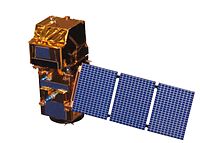
Photo from wikipedia
ABSTRACT Comprehensive monitoring of urban air pollution is paramount to better understand and work towards ameliorating hazardous air quality level in urban centres of India. This study aims at developing… Click to show full abstract
ABSTRACT Comprehensive monitoring of urban air pollution is paramount to better understand and work towards ameliorating hazardous air quality level in urban centres of India. This study aims at developing a multispectral empirical model useful in estimating the concentration of particulate matter of 2.5 micrometres (μm) or less in diameter (PM2.5) on a city-wide scale using Landsat 8 satellite’s data over the metropolis of Delhi, India. The data pertaining to PM2.5 mass concentration as well as meteorological parameters like relative humidity and temperature were taken from the field observation stations of the Central Pollution Control Board in New Delhi conform to the date of data collection from Landsat 8 satellite. The ambient reflectance in the visible spectrum bands was measured and compared with the in-situ concentration of PM2.5 and the meteorological evidence acquired from the Central Pollution Control Board (CPCB) and the Delhi Pollution Control Committee (DPCC). The correlation coefficient and root mean square error value were utilized to analyse the feasibility of the algorithm proposed. It can be concluded from the results that the aforementioned multispectral PM2.5 model can predict particulate matter concentrations with an adequate level of accuracy.
Journal Title: International Journal of Remote Sensing
Year Published: 2020
Link to full text (if available)
Share on Social Media: Sign Up to like & get
recommendations!